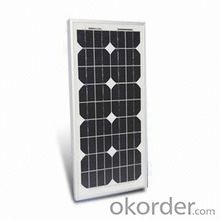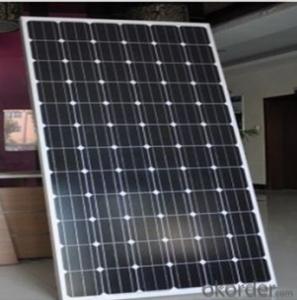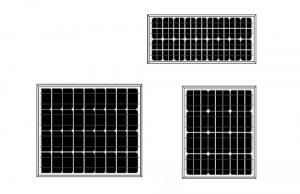Pure Solar Panels - Poly Solar Panel 290W B Grade with Cheapest Price
- Loading Port:
- Shanghai
- Payment Terms:
- TT OR LC
- Min Order Qty:
- 100 watt
- Supply Capability:
- 10000 watt/month
OKorder Service Pledge
OKorder Financial Service
You Might Also Like
Specification
Poly Solar Panel 290W B Grade with Cheapest Price
Product description
he photovoltaic effect was experimentally demonstrated first by French physicist Edmond Becquerel. In 1839, at age 19, he built the world's first photovoltaic cell in his father's laboratory. Willoughby Smith first described the "Effect of Light on Selenium during the passage of an Electric Current" in a 20 February 1873 issue of Nature. In 1883 Charles Fritts built the first solid state photovoltaic cell by coating the semiconductor selenium with a thin layer of gold to form the junctions; the device was only around 1% efficient.Solar cells are described as being photovoltaic irrespective of whether the source is sunlight or an artificial light. They are used as a photodetector (for example infrared detectors), detecting light or other electromagnetic radiation near the visible range, or measuring light intensity.
loss and possible damage because of the reverse bias applied to the shadowed cells by their illuminated partners. using independent MPPTs (maximum power point trackers) is preferable. Otherwise, shunt diodes can reduce shadowing power loss in arrays with series/parallel connected cells.[citation needed]

Application
Business
Home
Industry
Large project
Feature
1. A grade high efficiency solar cells.
2.TUV/UL/CE/CEC etc
3.Fast shippment
4.25 years warranty
5.OEM/ODM
Packaging
28pcs into one carton
Shipping
Material in stock can be produced (procedure 5-20days) right away after pre-payment confirmation. COSCO Mearsk MSCship to worldwide for safe shipping, don't worry about package damage or loss. It takes about 15-40 days to worldwide, Please note us your contact details include your phone number for easy contacting from shipping company officer.
- Q: Do solar panels require maintenance?
- Yes, solar panels do require some maintenance. Regular cleaning to remove dirt, dust, and debris is recommended to ensure optimal performance. Additionally, occasional inspections and maintenance checks by professionals are advisable to detect and address any issues or damage that may arise over time.
- Q: Can solar panels be used in areas with high levels of sand or dust deposition?
- Yes, solar panels can be used in areas with high levels of sand or dust deposition. However, the accumulation of sand or dust on the surface of the panels can reduce their efficiency over time. Regular cleaning and maintenance are necessary to ensure optimal performance in such environments. Additionally, certain design features, such as tilt angles and surface coatings, can be incorporated to minimize the impact of sand or dust deposition on solar panel efficiency.
- Q: Can solar panels be used for agricultural purposes?
- Yes, solar panels can be used for agricultural purposes. They can provide electricity for various agricultural operations such as irrigation systems, lighting, and powering machinery. Additionally, solar panels can be used to generate clean energy to reduce the carbon footprint of farming practices.
- Q: Why can't they put solar-panels on the blades and sides of the 300-500 foot tall turbines? Wouldn't this increase effeciency? Therefore, boosting pay-back time, profits, energy-output?
- It would work better to put the solar panels on the ground beneath the windmills. Land underneath wind farms is perfectly usable for other things, and it gets plenty of sun. But then, if you think about good places for solar panels, parking lots make even more sense yet. There's plenty of em, and people like to park in the shade.
- Q: i need to make a solar panel model for a project in science and i would like to know how to build a easy model at home that wont cost alot
- There are different types of solar panels. Photovoltaic for electricity, and thermal for heating water, and passive for heating air. So it would help if you would say what type you are going to build. Theere are a lot of videos on you tube on how to make solar panels. use the link below.
- Q: Aren't batteries bad for the environment?Toxic?Expensive? With small solar panels phones, iPod's, laptops other small electronics could be smaller, slimmer, more efficient cost people less to charge every day. Maybe a small battery inside as a backup and to store the Solar energy for night time. But overall, batteries should be optional. So big question:Why aren't electronics being produced with solar panels?
- Actually, I have gone through quite a few solar powered radios-though they had rechargeable batteries. Still have a solar powered flashlight. Leave 'em out in the sun for a few hours and your get an hour of radio, or a day or so of light. That doesn't get rid of the batteries thought (Which are built-in rechargables)
- Q: For example, If I were powering my house with solar panels, would it be more efficient or effective, (or I guess would I get more energy) out of a day that measured 90 degrees Fahrenheit as opposed to a day that is 70 degrees Fahrenheit.
- Not at all. You`ll generate more energy on a clear sunny day in the winter time than you would on a cloudy day in the summer.
- Q: are there solar panel that work without the sun?
- Unfortunately, okorder
- Q: Can solar panels work at night?
- No, solar panels cannot work at night as they rely on sunlight to generate electricity.
- Q: can i put a solar panel on a projector. if nt wat is a low energy projector that i can watch movies and play games on
- Solar panels put out DC voltage, like a battery. The projectors that plug into the wall require AC voltage. Unless you got a travel projector that plugs into a cigarette lighter (does that exist?), you would need to convert the DC power from the solar panel to AC for the projector with an inverter. And if you want to use it when the sun isn't shining, you'd need batteries to store the power.
Send your message to us
Pure Solar Panels - Poly Solar Panel 290W B Grade with Cheapest Price
- Loading Port:
- Shanghai
- Payment Terms:
- TT OR LC
- Min Order Qty:
- 100 watt
- Supply Capability:
- 10000 watt/month
OKorder Service Pledge
OKorder Financial Service
Similar products
Hot products
Hot Searches


























